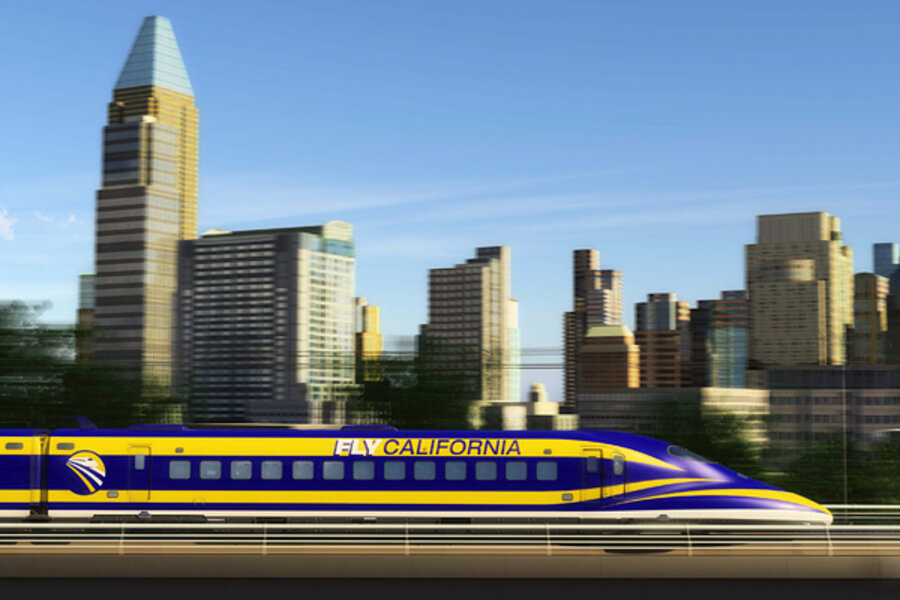A lot riding on California dream of high-speed rail
Loading...
| Los Angeles
California is moving ahead with the first link of its massive high-speed rail project, with construction set to begin early next year – even though not one state Republican lawmaker voted to fund it and despite several analyses warning of planning deficiencies.
Eventually, sleek trains that can top 220 miles per hour would whiz up and down the state, linking Sacramento, San Francisco, Los Angeles, and San Diego, and many cities in between. But that grand vision is at least $68 billion and 17 years away, and there are more than a few in California who doubt it will ever materialize.
Still, the Democratic-led state Legislature voted in July to spend $4.7 billion in state money to start on the 768-mile rail system, a move that triggers the Feds to kick in another $3.3 billion. California Gov. Jerry Brown (D) has been nothing short of rhapsodic about the project, attacking its critics as unimaginative and simply "wrong."
The high-speed rail gambit has a lot riding on it. It has the potential to put California in the vanguard of a transportation revolution for the 21st century – or to catapult the state into the financial abyss. In the meantime, it will certainly provide some jobs, starting in the agrarian Central Valley, where unemployment is about four percentage points higher than the state average of 10.7 percent.
"Governor Brown is seeking to define his legacy, and public mass transportation is one of the things in which he deeply believes," says Michael Shires, a public policy specialist at Pepperdine University in Malibu, Calif. "The creation of a high-speed rail link would allow him to leave an imprint on the state that is in the same universe as his father's legacy of water projects, universities, and highways," he adds, referring to Gov. Edmund "Pat" Brown's tenure at the helm of California in the 1960s.
Groundbreaking is set for January on a 30-mile segment between Fresno and Madera – a construction schedule that has prompted critics to ridicule the entire undertaking as "the train to nowhere."
Moreover, several audits and reports have expressed concern that the funding to finish the project won't be available, lacks sufficient oversight, and doesn't comply with a 2008 ballot measure by which voters authorized use of state funds for high-speed rail in the first place. A statewide Field poll in June concluded that Californians, if asked today, would vote down the project.
The California High-Speed Rail Authority now has a new board chairman, a new chief executive officer, and a revised business plan. An independent peer review group, in a review of the revised business plan, noted "substantial improvement," but also said uncertainties surrounding future funding are unresolved.
What high-speed rail proponents have going for them is widespread agreement that something must be done to accommodate the millions more people who will populate the Golden State by midcentury. California's population was about 34 million in 2000, will probably exceed 40 million this year, and is forecast to swell to 50 million by 2032 and almost 60 million by 2050, according to the US Census Bureau and the California Department of Finance.
If the rail project is not built, "either we will have more gridlock or be forced to invest in more freeways and airports," says Robert Stern, former president of the Center for Governmental Studies and a backer of the train expansion. "If this succeeds, California will ... be leading the nation in the 21st century, just as it did with its freeways, universities, high tech, and other innovations in the 20th century."
In embracing spending for high-speed rail, Brown takes a giant political gamble. He wants Californians to approve a ballot measure in November to raise taxes, and the rail project spending could affect how voters feel about that. If the measure fails, the Legislature will have to find $6 billion more in budget cuts – on top of the $8.3 billion in across-the-board cuts it has already authorized – to balance this year's state budget.
"The rail project will make it tougher for him to gain public support" for the tax measure, says Jack Pitney, professor of government at Claremont McKenna College in Claremont, Calif. Brown "says that the tax hike is necessary to prevent cuts in education. But with the bullet train, he sounds like a father who lets his kids go hungry while he goes out and buys a Cadillac."







